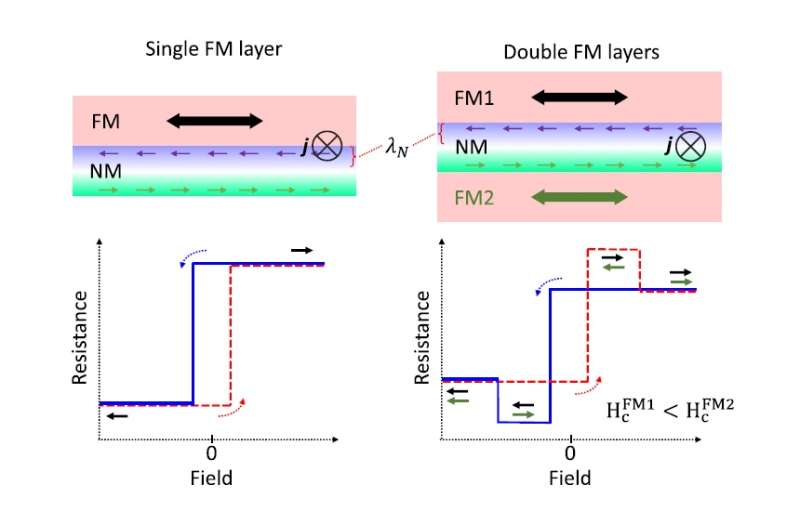June 5, 2017 feature
New magnetoresistance effect leads to four-state memory device

(Phys.org)—In 2015, scientists discovered a new magnetoresistance effect—that is, a new way in which magnetization affects a material's electric resistance—but hadn't yet found a promising application for the discovery, beyond the existing technologies. Now in a new paper, the same researchers have demonstrated that the effect can be used to design memories with four distinct stable magnetic states, allowing the memories to store four bits of information in a single magnetic structure.
The researchers, Can Onur Avci et al., at MIT and ETH Zürich, have published a paper on the new memory concept in a recent issue of Applied Physics Letters.
"With some device and structural optimization, the bit density of existing random access memory devices may be increased by several factors, with the possibility of all-electrical operation," Avci told Phys.org.
Magnetoresistance effects date back to around 1850, when Lord Kelvin demonstrated that applying a magnetic field to a metal object increases the object's electric resistance in one direction and decreases it in the perpendicular direction. Since then, several other types of magnetoresistance have been discovered. Most notably, Albert Fert and Peter Grünberg won the 2007 Nobel Prize in Physics for their discovery of giant magnetoresistance, which is used to make magnetic field sensors that are found in many of the hard disk drives in today's computers.
In 2015, scientists discovered the newest magnetoresistance effect, called unidirectional spin Hall magnetoresistance. This effect differs from other kinds of magnetoresistance in that the change in resistance depends on the direction of either the magnetization or the electric current. As the scientists explain, this direction-dependent effect occurs because the spin-polarized electrons created by the spin Hall effect in a nonmagnetic layer are deflected in opposite directions by the magnetization of the adjacent magnetic layer.
Previously, this new effect was demonstrated in two-layer structures consisting of a nonmagnetic and a magnetic layer. But by adding another magnetic layer, the researchers achieved a great potential advantage for memories: the ability to distinguish between not just two, but four magnetic states. Other types of magnetoresistance effects are only sensitive to the relative orientation of the magnetizations (parallel or antiparallel), although it's possible to have four distinct magnetic states. Because the new effect is sensitive to the magnetization direction of individual layers, it can distinguish between all four states.
The researchers then demonstrated four distinct resistance levels corresponding to the four different magnetic states in their three-layer device. They showed that the four resistance levels can be read out by a simple electric measurement, paving the way for the development of an all-electrical multi-bit-per-cell memory device.
The researchers expect that it will be possible to scale up this memory device to higher bit densities by adding more layers, which could realistically enable eight different magnetization states, each with its own unique resistance level. In the future, the researchers also plan to look for materials that exhibit a larger unidirectional spin Hall magnetoresistance effect, which would further enhance the performance of these memory devices.
More information: Can Onur Avci et al. "A multi-state memory device based on the unidirectional spin Hall magnetoresistance." Applied Physics Letters. DOI: 10.1063/1.4983784
ABSTRACT
We report on a memory device concept based on the recently discovered unidirectional spin Hall magnetoresistance (USMR), which can store multiple bits of information in a single ferromagnetic heterostructure. We show that the USMR with possible contribution of Joule heating-driven magnetothermal effects in ferromagnet/normal metal/ferromagnet (FM/NM/FM) trilayers gives rise to four different 2nd harmonic resistance levels corresponding to four magnetization states (⇉⇉, ⇄⇄, ⇆⇆, ⇇⇇) in which the system can be found. Combined with the possibility of controlling the individual FMs by spin-orbit torques, we propose that it is possible to build an all-electrical lateral two-terminal multi-bit-per-cell memory device.
Journal information: Applied Physics Letters
© 2017 Phys.org




















